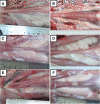Anti-idiotypic antibodies reduce efficacy of the attenuated vaccine against highly pathogenic PRRSV challenge
- PMID: 24507659
- PMCID: PMC3921987
- DOI: 10.1186/1746-6148-10-39
Anti-idiotypic antibodies reduce efficacy of the attenuated vaccine against highly pathogenic PRRSV challenge
Abstract
Background: The inability of current vaccines to provide effective protection against porcine reproductive and respiratory syndrome virus (PRRSV) infection is not fully understood. One of the reasons might be the presence of anti-idiotypic antibodies (Ab2s) to the envelope glycoprotein GP5 induced by PRRSV infection since our previous studies demonstrated the presence of auto-Ab2s (aAb2s) in pigs infected with PRRSV. To test this hypothesis, PRRSV negative piglets were injected with a monoclonal Ab2 (Mab2-5G2) and aAb2s that are specific for anti-GP5 antibody, vaccinated with the attenuated PRRSV vaccine CH-1R and then challenged with the highly pathogenic PRRSV HuN4 strain. The animals were evaluated for clinical signs, pathological changes of the thymus and lungs, viremia, levels of serum antibodies and cytokines.
Results: The piglets injected with Mab2-5G2 or aAb2, and who received the attenuated PRRSV vaccine CH-1R before challenge, produced high levels of anti-N antibodies, IL-2 and IL-4, but low levels of neutralizing antibodies. After PRRSV HuN4 challenge, the animals showed obvious clinical signs, including lung lesions, severe thymus atrophy and decreased production of IL-4 and higher level of viremia.
Conclusion: When anti-GP5 Ab2s are present, the use of attenuated PRRSV vaccine CH-1R against HP-PRRSV infection is not recommended. It can result in poor health status with pneumonia and thymus atrophy.
Figures





Similar articles
-
A porcine reproductive and respiratory syndrome virus candidate vaccine based on the synthetic attenuated virus engineering approach is attenuated and effective in protecting against homologous virus challenge.Vaccine. 2016 Nov 4;34(46):5546-5553. doi: 10.1016/j.vaccine.2016.09.049. Epub 2016 Oct 11. Vaccine. 2016. PMID: 27742217
-
Comparison of two genetically distant type 2 porcine reproductive and respiratory syndrome virus (PRRSV) modified live vaccines against Vietnamese highly pathogenic PRRSV.Vet Microbiol. 2015 Sep 30;179(3-4):233-41. doi: 10.1016/j.vetmic.2015.06.013. Epub 2015 Jun 26. Vet Microbiol. 2015. PMID: 26149103 Clinical Trial.
-
Efficacy of a live attenuated highly pathogenic PRRSV vaccine against a NADC30-like strain challenge: implications for ADE of PRRSV.BMC Vet Res. 2021 Jul 31;17(1):260. doi: 10.1186/s12917-021-02957-z. BMC Vet Res. 2021. PMID: 34332554 Free PMC article.
-
Generation of internal image monoclonal anti-idiotypic antibodies against idiotypic antibodies to GP5 antigen of porcine reproductive and respiratory syndrome virus.J Virol Methods. 2008 May;149(2):300-8. doi: 10.1016/j.jviromet.2008.01.010. Epub 2008 Mar 11. J Virol Methods. 2008. PMID: 18336924
-
Assessment of the safety and efficacy of an attenuated live vaccine based on highly pathogenic porcine reproductive and respiratory syndrome virus.Clin Vaccine Immunol. 2015 May;22(5):493-502. doi: 10.1128/CVI.00722-14. Epub 2015 Mar 4. Clin Vaccine Immunol. 2015. PMID: 25739919 Free PMC article.
Cited by
-
Immune Control of PRRS: Lessons to be Learned and Possible Ways Forward.Front Vet Sci. 2014 Oct 14;1:2. doi: 10.3389/fvets.2014.00002. eCollection 2014. Front Vet Sci. 2014. PMID: 26664910 Free PMC article. Review.
-
Rescue and evaluation of a recombinant PRRSV expressing porcine Interleukin-4.Virol J. 2015 Nov 14;12:185. doi: 10.1186/s12985-015-0380-7. Virol J. 2015. PMID: 26573719 Free PMC article.
-
Roles of MOV10 in Animal RNA Virus Infection.Front Vet Sci. 2020 Sep 16;7:569737. doi: 10.3389/fvets.2020.569737. eCollection 2020. Front Vet Sci. 2020. PMID: 33195554 Free PMC article. Review.
References
-
- Cavanagh D. Nidovirales: a new order comprising Coronaviridae and Arteriviridae. Arch Virol. 1997;142(3):629–633. - PubMed
-
- Benfield DA, Nelson E, Collins JE, Harris L, Goyal SM, Robison D, Christianson WT, Morrison RB, Gorcyca D, Chladek D. Characterization of swine infertility and respiratory syndrome (SIRS) virus (isolate ATCC VR-2332) J Vet Diagn Invest. 1992;4(2):127–133. doi: 10.1177/104063879200400202. - DOI - PubMed
-
- Labarque GG, Nauwynck HJ, Van Reeth K, Pensaert MB. Effect of cellular changes and onset of humoral immunity on the replication of porcine reproductive and respiratory syndrome virus in the lungs of pigs. J Gen Virol. 2000;81(Pt 5):1327–1334. - PubMed
Publication types
MeSH terms
Substances
LinkOut - more resources
Full Text Sources
Other Literature Sources
Research Materials
Miscellaneous

